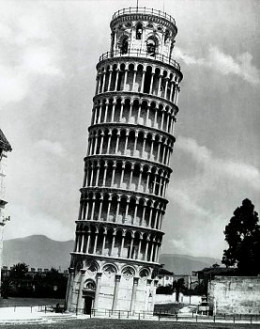Let 2 kg of feathers and 1 kg of iron are falling from the same height.What woul
Let 2 kg of feathers and 1 kg of iron are falling from the same height.What would be first to fall?
Discuss your opinion. Photo: Leaning Tower of Pisa, Italy, where Galileo Galilei performed experiments on free fall (source: corbisimage.com).
First to fall... or first to land? And can I assume the feathers are bound in some way!
It would depend on how the feathers are packaged. Let's assume the iron is a ball and the feathers are in a mesh bag. Depending on atmospheric conditions, the feathers could present greater wind resistance than the iron ball, making them slower to reach the ground. If they were compressed into a similar ball shape as the iron ball, and compressed to a point where they were quite firm in the ball shape, they would likely reach the ground sooner.
Hi flysky,
I'm assuming that we're talking about free-fall in a perfect vacuum, that the heights of the two packages are the same (obviously, the width of the feathers package will be much greater), and that the effects of the Earth's magnetic field on the iron is negligible. Then the heavier feathers package should complete its fall SLIGHTLY faster than the iron package. Why?
The Earth and either of the two packages will be attracted to the center of mass of the corresponding system. For the heavier feathers-Earth system, the distance from the center of mass of the feathers to the center of mass of the system is SLIGHTLY less than for the iron experiment. The acceleration due to gravity is the same for both experiments. Therefore the feathers package will finish its fall in slightly less time, because the length of that fall is slightly less.I think that Neil Armstrong's experiment and videos on the moon say it all. The hammer and the feather fell at the same time and hit at the same time when on the moon. They "should" fall at the same rate of acceleration... or should they?
We have a slight problem Huston. The moon has much less air resistance than earth. Most chunks of iron would be assembled in such a way to have lower air resistance than the feathers. The force of the air will not slow down the iron and therefore it will, on a planet with a reasonable amount of atmosphere, accelerate to the ground more quickly.
But wait... there's more!
That's right. For today only we will provide you with 3 answers for the price of one! (Unlike the TV ads I will also give out free shipping. For today only!)
If you create a structure that can withstand a vacuum and hold both objects they can fall at the same rate on earth. Place the objects in a clamp at the top of the container, remove the air, drop the items and see which hits first.
"Both," you say?
My dear Sir, you are correct.
So then, which falls faster? The chicken... oh wait wrong answer...
Which accelerates towards earth at a greater pace? Neither or iron is the correct answer due to the variances in air resistance.Thank you to all of you for a great discussion! I asked this question since I noticed that people like to discuss it, from time to time asking me for my opinion. The textbook version of the question (we neglect air resistance, as well as possible minor effects – including the one that Larry mentioned) is quite known: free fall doesn't depend on mass, as all answers state or suggest.
- scottcgruberposted 12 years ago
0
This question has me thinking. If we assume the iron to be a ball shape and the feathers are unbound, the ball will hit first while the feathers are still fluttering to the ground.
What shape would the iron have to be so that the feathers hit the ground first?
If you pounded the iron out into the shape of a glider or a parachute, you could probably slow it down enough to make the feathers hit first.
This would be a good Mythbusters episode...
Related Discussions
- 17
What would you do if you were to fall in love with someone who was not available
by Jo Alexis-Hagues 13 years ago
What would you do if you were to fall in love with someone who was not available?
- 25
Why do Christians fall down in prayer?
by Marliza Gunter 8 years ago
Why do Christians fall down in prayer?I can't find in the bible where Jesus or the disciples made the people to fall under the anointing. The thing is, a non believer said such things are fake and there is no mention of this phenomena written in the New Testament...what should I answer...
- 2
Soon after we fall asleep, why do we dream that we are falling and wake up with
by Alwaysme 14 years ago
Soon after we fall asleep, why do we dream that we are falling and wake up with a shock??
- 3
What is the height of the ball horizontally kicked (see figure)?
by flysky 12 years ago
What is the height of the ball horizontally kicked (see figure)?...if the angle alpha is 45 0 and the coefficient of friction is 0.21. Due to the friction the ball will stop after 1m.
- 8
How to know if someone just fall in love?
by yanie 12 years ago
How to know if someone just fall in love?
- 6
Is falling in love with a girl/boy a sin?
by OSBERT JOEL C 11 years ago
Is falling in love with a girl/boy a sin?












